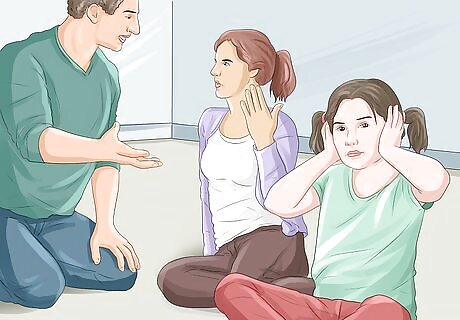
views
Determining That The Parent Is Unfit

Observe his or her behavior. If a parent is a danger to the child, or if the parent puts the child in dangerous situations, then it may not be in the child's best interests to remain with that parent. Consider any past instances of the following (especially repeated examples of that type of behavior): Violent acts; Excessive disciplining; Emotional abuse; Abuse of drugs or alcohol; or Past convictions for sexual offenses.

Examine the child's environment. Sometimes, a parent may place the child in dangerous circumstances, or create or allow dangerous circumstances in the parent's home. Consider the following: Is the child properly supervised? Is the parent supervising the child or leaving that responsibility to someone else? Is the parent ensuring that the child is adequately fed, clothed, and educated? Is the parent friends with gang members, drug abusers, criminals, or abusive persons? Is the child in contact with these people? Does the child have personal space in the home, with heat and plumbing? Does the parent allow dangerous conditions in the house, such as failing to safely store firearms or harmful chemicals?

Assemble evidence. In order to argue that the child should be removed from the parent's custody, you will need to show some evidence of the parent's behavior or the child's environment that establishes that the parent is a danger do the child. Gather any of the following evidence that you can: Pictures, video, and audio files showing injuries, physical abuse, or verbal abuse; Medical records for treatment related to injuries to the child; Criminal records of the parent; and Emails, texts, and voicemails from the parent.

Speak with witnesses. Other people can help your establish that the child should be removed from the parent's custody. Talk to friends and family members who have seen the parent harming, endangering, or threatening to harm the child. Ask the witness for as much detail as he or she can give you about the incident, then ask if he or she would be willing to testify about their observations in court. Also ask your witnesses if they have any additional evidence you might be able to use, such as emails or voicemails from the parent.
Petitioning the Court to Modify or Terminate Custody

Initiate your case. Before you can ask a court to change or terminate a parent's custody rights, you need to file your case with the court clerk. Start your case by doing one of the following: Contact the Department of Child Protective Services (CPS) in your state. Your state's CPS office is tasked with protecting the wellbeing of children. Depending on the policies of the office, your local CPS office may be able to investigate and file your case for you. File for divorce. If you are married to the child's other parent, custody of the child will be a key issue in the dissolution proceedings. In your petition for dissolution, explain the custody arrangement you want and why the other parent should be awarded little or no custody. File a petition for custody. You can file a petition to establish custody if you are the child's father and were never married to the child's mother. If you are already divorced from the other parent and you want to change the current custody arrangement, you can petition to modify the custody order. Call or visit the court clerk and ask what forms you need to submit to make your request. Use the space provided on the forms to explain what arrangement you would like and why the other parent's custody rights should be reduced. File a guardianship petition. If you are not one of the child's parents, you can still file to become the child's legal guardian. Ask the court clerk what forms you need to submit to make your request. Use the space provided on the forms to explain why the child should be removed from his or parents and placed in your care.

File your forms. When filing for divorce, custody, or guardianship, make several copies of your forms and take them to the court clerk. The clerk will stamps your forms as "filed," keep the original, and return the copies to you. You may need to pay a filing fee. The clerk will notify you by mail once a date has been set for the hearing. To file for custody or guardianship, you need to file in the county where the child lives. If you cannot afford the filing fee, ask the court clerk how to apply for a fee waiver. You will need to give detailed information about your household finances, and the judge will consider whether or not you meet the criteria to have your fees waived.

Serve the parent. Once you have file your documents, you will need to serve the parent with notice of the case. Different courts have different rules about how to serve parties. You may be allowed to file a "Waiver" or "Acceptance of Service" signed by the parent instead of having the parent formally served. Otherwise, do one of the following: Ask the court clerk if the clerk's office will serve the parent; Hire the sheriff's office or a professional process server; or Have a friend or relative over 18 years old and not involved in the case to deliver the documents to the parent.

File a Proof of Service. Make sure that your process server fills out and signs a "Proof of Service" or "Affidavit of Service" form, which you can get from the court clerk. This form verifies that the server personally served the parent. Take the signed Proof of Service to the clerk for filing.
Presenting Your Case in Court

Go to the hearing. One the date of the hearing, dress professionally, arrive early, and wait for the judge to call your case. The judge will then ask you why you have requested that the parent's custody of the child be terminated or modified. The parent will be able to argue that custody should not be taken from him or her, and that it would not be in the best interests of the child to do so. Both sides will have the opportunity to present witnesses and evidence to support his or her position.

Present evidence. Bring any evidence you would like to present with you to the hearing. This can include documents and photographs (both originals and copies), videos, and audio files. Burn any video or audio files to a CD in advance. Have your physical evidence organized in a binder in chronological order so that you can quickly refer to each item during the proceedings. If any of your evidence was given to you by a witness, ask the witness about that evidence during his or her testimony. You will need to argue not only that the parent is unfit, but that placing the child in your care would be in the child's best interests. To show that you can give the child a safe and stable home, include a copy of your lease or mortgage with your evidence to show that you are financially responsible.

Give witness testimony. Both you and your witnesses will have a change to testify about why you believe the parent is unfit. If you are represented by an attorney, he or she will ask questions to guide you through your testimony. If you are self-represented, simply explain each incident to the judge and answer any questions he or she has for you. After you testify, ask the judge to allow you to present your witnesses. The child may be allowed to testify at the hearing. Each state has its own rules about whether and when a child's testimony is admissible in court. In Ohio, for example, children over 10 are generally allowed to testify, while children under 10 must be interviewed by the court and found to be able to understand questions and tell the truth. After each witness gives testimony, the other side will be allowed to cross-examine the witness. When you are cross-examined, give short and truthful answers, and do not be afraid to admit it when you do not know the answer to a question.

Obey the court's orders. At the end of the hearing, the judge may make an order regarding custody of the child, or announce that he or she needs additional information before making a decision. If more information is needed, the court will order a child custody evaluation and appoint an independent evaluator to visit the parties' homes and interview the parties, child and friends and family. The evaluator may also schedule appointments for psychological evaluations. If a custody evaluation is ordered by the judge, the clerk will set another hearing date. Participate in the evaluation process and then return to court on the hearing date for the judge's ruling on your petition.



















Comments
0 comment